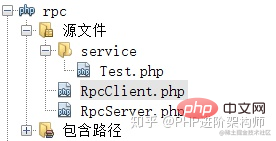 Backend Development
Backend Development
 PHP Tutorial
PHP Tutorial
 Analyze how PHP can quickly create RPC services (code demonstration)
Analyze how PHP can quickly create RPC services (code demonstration)
Analyze how PHP can quickly create RPC services (code demonstration)
This article will introduce to you what RPC is and how to use PHP to create an RPC service simply and quickly. It is actually very simple. Let’s take a look~ I hope it will be helpful to friends in need~

RPC stands for Remote Procedure Call, which translates to "remote procedure call". Mainly used for remote communication and mutual calls between different systems. [Recommended learning: PHP video tutorial]
For example, there are two systems, one is written in PHP and the other is written in JAVA, and PHP wants to call a certain class in JAVA For a certain method, RPC needs to be used at this time.
How to adjust? Direct adjustment is impossible. PHP can only request JAVA's services through some custom protocol. JAVA parses the protocol, instantiates the class locally and calls the method, and then returns the result to PHP.
Here we use PHP's socket extension to create a server and client to demonstrate the calling process.
RpcServer.php code is as follows:
<?php
class RpcServer {
protected $serv = null;
public function __construct($host, $port, $path) {
//创建一个tcp socket服务
$this->serv = stream_socket_server("tcp://{$host}:{$port}", $errno, $errstr);
if (!$this->serv) {
exit("{$errno} : {$errstr} \n");
}
//判断我们的RPC服务目录是否存在
$realPath = realpath(__DIR__ . $path);
if ($realPath === false || !file_exists($realPath)) {
exit("{$path} error \n");
}
while (true) {
$client = stream_socket_accept($this->serv);
if ($client) {
//这里为了简单,我们一次性读取
$buf = fread($client, 2048);
//解析客户端发送过来的协议
$classRet = preg_match('/Rpc-Class:\s(.*);\r\n/i', $buf, $class);
$methodRet = preg_match('/Rpc-Method:\s(.*);\r\n/i', $buf, $method);
$paramsRet = preg_match('/Rpc-Params:\s(.*);\r\n/i', $buf, $params);
if($classRet && $methodRet) {
$class = ucfirst($class[1]);
$file = $realPath . '/' . $class . '.php';
//判断文件是否存在,如果有,则引入文件
if(file_exists($file)) {
require_once $file;
//实例化类,并调用客户端指定的方法
$obj = new $class();
//如果有参数,则传入指定参数
if(!$paramsRet) {
$data = $obj->$method[1]();
} else {
$data = $obj->$method[1](json_decode($params[1], true));
}
//把运行后的结果返回给客户端
fwrite($client, $data);
}
} else {
fwrite($client, 'class or method error');
}
//关闭客户端
fclose($client);
}
}
}
public function __destruct() {
fclose($this->serv);
}
}
new RpcServer('127.0.0.1', 8888, './service');RpcClient.php code is as follows:
<?php
class RpcClient {
protected $urlInfo = array();
public function __construct($url) {
//解析URL
$this->urlInfo = parse_url($url);
if(!$this->urlInfo) {
exit("{$url} error \n");
}
}
public function __call($method, $params) {
//创建一个客户端
$client = stream_socket_client("tcp://{$this->urlInfo['host']}:{$this->urlInfo['port']}", $errno, $errstr);
if (!$client) {
exit("{$errno} : {$errstr} \n");
}
//传递调用的类名
$class = basename($this->urlInfo['path']);
$proto = "Rpc-Class: {$class};" . PHP_EOL;
//传递调用的方法名
$proto .= "Rpc-Method: {$method};" . PHP_EOL;
//传递方法的参数
$params = json_encode($params);
$proto .= "Rpc-Params: {$params};" . PHP_EOL;
//向服务端发送我们自定义的协议数据
fwrite($client, $proto);
//读取服务端传来的数据
$data = fread($client, 2048);
//关闭客户端
fclose($client);
return $data;
}
}
$cli = new RpcClient('http://127.0.0.1:8888/test');
echo $cli->hehe();
echo $cli->hehe2(array('name' => 'test', 'age' => 27));Then run the above two scripts respectively (note that php needs to add environment variables)
> php RpcServer.php > php RpcClient.php
The results are as follows:


Test.php code is as follows:
<?php
class Test {
public function hehe() {
return 'hehe';
}
public function hehe2($params) {
return json_encode($params);
}
}The directory structure is as follows:

Our customized protocol above can be modified at will, as long as the client and server can be unified and parsed.
The client passes the class, method and parameters to be called to the server by requesting the server, and the server returns the result by instantiating the calling method.
The above is the detailed content of Analyze how PHP can quickly create RPC services (code demonstration). For more information, please follow other related articles on the PHP Chinese website!

Hot AI Tools

Undresser.AI Undress
AI-powered app for creating realistic nude photos

AI Clothes Remover
Online AI tool for removing clothes from photos.

Undress AI Tool
Undress images for free

Clothoff.io
AI clothes remover

AI Hentai Generator
Generate AI Hentai for free.

Hot Article

Hot Tools

Notepad++7.3.1
Easy-to-use and free code editor

SublimeText3 Chinese version
Chinese version, very easy to use

Zend Studio 13.0.1
Powerful PHP integrated development environment

Dreamweaver CS6
Visual web development tools

SublimeText3 Mac version
God-level code editing software (SublimeText3)

Hot Topics
 1378
1378
 52
52
 PHP 8.4 Installation and Upgrade guide for Ubuntu and Debian
Dec 24, 2024 pm 04:42 PM
PHP 8.4 Installation and Upgrade guide for Ubuntu and Debian
Dec 24, 2024 pm 04:42 PM
PHP 8.4 brings several new features, security improvements, and performance improvements with healthy amounts of feature deprecations and removals. This guide explains how to install PHP 8.4 or upgrade to PHP 8.4 on Ubuntu, Debian, or their derivati
 How To Set Up Visual Studio Code (VS Code) for PHP Development
Dec 20, 2024 am 11:31 AM
How To Set Up Visual Studio Code (VS Code) for PHP Development
Dec 20, 2024 am 11:31 AM
Visual Studio Code, also known as VS Code, is a free source code editor — or integrated development environment (IDE) — available for all major operating systems. With a large collection of extensions for many programming languages, VS Code can be c
 7 PHP Functions I Regret I Didn't Know Before
Nov 13, 2024 am 09:42 AM
7 PHP Functions I Regret I Didn't Know Before
Nov 13, 2024 am 09:42 AM
If you are an experienced PHP developer, you might have the feeling that you’ve been there and done that already.You have developed a significant number of applications, debugged millions of lines of code, and tweaked a bunch of scripts to achieve op
 How do you parse and process HTML/XML in PHP?
Feb 07, 2025 am 11:57 AM
How do you parse and process HTML/XML in PHP?
Feb 07, 2025 am 11:57 AM
This tutorial demonstrates how to efficiently process XML documents using PHP. XML (eXtensible Markup Language) is a versatile text-based markup language designed for both human readability and machine parsing. It's commonly used for data storage an
 Explain JSON Web Tokens (JWT) and their use case in PHP APIs.
Apr 05, 2025 am 12:04 AM
Explain JSON Web Tokens (JWT) and their use case in PHP APIs.
Apr 05, 2025 am 12:04 AM
JWT is an open standard based on JSON, used to securely transmit information between parties, mainly for identity authentication and information exchange. 1. JWT consists of three parts: Header, Payload and Signature. 2. The working principle of JWT includes three steps: generating JWT, verifying JWT and parsing Payload. 3. When using JWT for authentication in PHP, JWT can be generated and verified, and user role and permission information can be included in advanced usage. 4. Common errors include signature verification failure, token expiration, and payload oversized. Debugging skills include using debugging tools and logging. 5. Performance optimization and best practices include using appropriate signature algorithms, setting validity periods reasonably,
 PHP Program to Count Vowels in a String
Feb 07, 2025 pm 12:12 PM
PHP Program to Count Vowels in a String
Feb 07, 2025 pm 12:12 PM
A string is a sequence of characters, including letters, numbers, and symbols. This tutorial will learn how to calculate the number of vowels in a given string in PHP using different methods. The vowels in English are a, e, i, o, u, and they can be uppercase or lowercase. What is a vowel? Vowels are alphabetic characters that represent a specific pronunciation. There are five vowels in English, including uppercase and lowercase: a, e, i, o, u Example 1 Input: String = "Tutorialspoint" Output: 6 explain The vowels in the string "Tutorialspoint" are u, o, i, a, o, i. There are 6 yuan in total
 Explain late static binding in PHP (static::).
Apr 03, 2025 am 12:04 AM
Explain late static binding in PHP (static::).
Apr 03, 2025 am 12:04 AM
Static binding (static::) implements late static binding (LSB) in PHP, allowing calling classes to be referenced in static contexts rather than defining classes. 1) The parsing process is performed at runtime, 2) Look up the call class in the inheritance relationship, 3) It may bring performance overhead.
 What are PHP magic methods (__construct, __destruct, __call, __get, __set, etc.) and provide use cases?
Apr 03, 2025 am 12:03 AM
What are PHP magic methods (__construct, __destruct, __call, __get, __set, etc.) and provide use cases?
Apr 03, 2025 am 12:03 AM
What are the magic methods of PHP? PHP's magic methods include: 1.\_\_construct, used to initialize objects; 2.\_\_destruct, used to clean up resources; 3.\_\_call, handle non-existent method calls; 4.\_\_get, implement dynamic attribute access; 5.\_\_set, implement dynamic attribute settings. These methods are automatically called in certain situations, improving code flexibility and efficiency.



